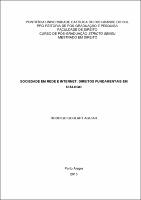| Share record |


|
Please use this identifier to cite or link to this item:
https://tede2.pucrs.br/tede2/handle/tede/6116Full metadata record
| DC Field | Value | Language |
|---|---|---|
| dc.creator | Aguiar, Rodrigo Goulart | - |
| dc.creator.Lattes | http://buscatextual.cnpq.br/buscatextual/visualizacv.do?id=K4319876H7 | por |
| dc.contributor.advisor1 | Molinaro, Carlos Alberto | - |
| dc.date.accessioned | 2015-06-10T12:03:46Z | - |
| dc.date.issued | 2015-03-31 | - |
| dc.identifier.uri | http://tede2.pucrs.br/tede2/handle/tede/6116 | - |
| dc.description.resumo | A Sociedade-rede passou a ter seus contornos delineados por intermédio das tecnologias da informação e comunicação - TICs, notadamente após o advento da Internet. Nesse contexto, fundado nos preceitos da dignidade da pessoa humana e livre desenvolvimento da personalidade, depreende-se o reconhecimento do direito fundamental ao acesso à Internet. No ambiente virtual as escalas de espaço e tempo foram drasticamente alteradas. O crescimento quantitativo de informações veiculadas na Rede ganhou feições qualitativas, representando riscos a direitos de diversas ordens, tais como o direito à privacidade e à proteção de dados pessoais. Entidades públicas e especialmente empresas privadas de âmbito mundial empregam tecnologias avançadas de processamento massivo de dados. O resultado desse processo é a elaboração de perfis individuais e coletivos que servem como base para o implemento de programas de cunho mercadológico e discriminatório. Nesse sentido, reconhecida a relação simbiôntica entre Direito e Internet, extrai-se a necessidade de regulação jurídica da Internet em meio à sociedade de vigilância. Ciente de que a abordagem jurídica tradicional não acompanha a evolução tecnológica do ambiente virtual, novos modelos regulatórios são necessários. Sob essa ótica, apresenta-se o modelo misto proposto por Lawrence Lessig, fruto da interação recíproca das normas sociais, mercado, Direito e a arquitetura da Rede. Em complemento à proposta do autor, agrega-se a necessária reflexão acerca do comportamento do internauta na Rede, o implemento de políticas de cooperação internacional, bem como uma releitura dos contratos no ambiente virtual. Tal conjuntura revela o caráter regulador soberano do Direito e potencializa sua efetividade no ciberespaço. | por |
| dc.description.abstract | The network society has had its boundaries outlined through the information and communication technologies - ICTs, especially after the birth of the Internet. In that context, based on the rules of human dignity and free personality development, the acknowledgment of fundamental rights to access the Internet is a clear fact. In the virtual environment, the scales of space and time have changed dramatically. The quantitative growth of information broadcasted in the Web has gained qualitative features, representing risks to rights of several natures, such as the right to privacy and the protection of personal data. Government entities and especially private companies worldwide have been using advanced technologies of massive data processing. The result of such process is the elaboration of individual and collective profiles which are used as a basis for the implementation of software for marketing and discrimination usage. In that sense, once we acknowledge the symbiotic relation between Law and Internet, the necessity of legal regulation of the Internet amongst the surveillance society becomes clear. Aware that the traditional legal approach does not follow the technology evolution of the virtual environment, new regulation models are necessary. Under this view, there is the mixed model suggested by Lawrence Lessig, from the mutual interaction of the social standards, market, Law and the architecture of the Web. As a complement to the author’s suggestion, there is the necessary reflection about the Internet users’ behavior in the Web, the implementation of international cooperation policies, as well as a reinterpretation of the contracts in the virtual environment. Such situation reveals the sovereign regulator nature of the Law and boosts its effectiveness in the cyberspace. | eng |
| dc.description.provenance | Submitted by Setor de Tratamento da Informação - BC/PUCRS ([email protected]) on 2015-06-10T12:03:46Z No. of bitstreams: 1 470206 Texto Parcial.pdf: 292349 bytes, checksum: 3032a2e3e62757d84be952c9e728cc5f (MD5) | eng |
| dc.description.provenance | Made available in DSpace on 2015-06-10T12:03:46Z (GMT). No. of bitstreams: 1 470206 Texto Parcial.pdf: 292349 bytes, checksum: 3032a2e3e62757d84be952c9e728cc5f (MD5) Previous issue date: 2015-03-31 | eng |
| dc.format | application/pdf | * |
| dc.thumbnail.url | http://tede2.pucrs.br:80/tede2/retrieve/162870/470206%20%20Texto%20Parcial.pdf.jpg | * |
| dc.language | por | por |
| dc.publisher | Pontifícia Universidade Católica do Rio Grande do Sul | por |
| dc.publisher.department | Faculdade de Direito | por |
| dc.publisher.country | Brasil | por |
| dc.publisher.initials | PUCRS | por |
| dc.publisher.program | Programa de Pós-Graduação em Direito | por |
| dc.rights | Acesso Aberto | por |
| dc.subject | DIREITO | por |
| dc.subject | DIREITOS FUNDAMENTAIS | por |
| dc.subject | DIREITO À PRIVACIDADE | por |
| dc.subject | INTERNET - ASPECTOS JURÍDICOS | por |
| dc.subject | ARQUITETURA DE REDES | por |
| dc.subject.cnpq | CIENCIAS SOCIAIS APLICADAS::DIREITO | por |
| dc.title | Sociedade em rede e internet : direitos fundamentais em diálogo | por |
| dc.type | Dissertação | por |
| Appears in Collections: | Programa de Pós-Graduação em Direito | |
Files in This Item:
| File | Description | Size | Format | |
|---|---|---|---|---|
| 470206 Texto Parcial.pdf | Texto Parcial | 285.5 kB | Adobe PDF |  Download/Open Preview |
Items in DSpace are protected by copyright, with all rights reserved, unless otherwise indicated.




